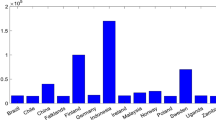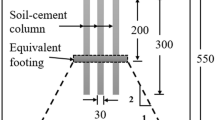Abstract
The aim of this paper was to determine the ultimate vertical bearing capacity of rectangular rigid footings resting on homogeneous peat stabilized by a group of cement deep mixing (CDM) columns. For this purpose, a series of physical modeling tests involving end-bearing and floating CDM columns were performed. Three length/depth ratios of 0.25, 0.5, and 0.75 and three area improvement ratios of 13.1, 19.6, and 26.2 % were considered. Bearing capacity of the footings was studied using different analytical procedures. The results indicated that compared to unimproved peat, the average ultimate bearing capacity (UBC) improvement of floating and end-bearing CDM columns were 60 and 223 %, respectively. The current study found that simple Brom’s method predicted the UBC of the peat stabilized with floating CDM columns with reasonable accuracy, but underestimated the UBC by up to 25 % in the case of end-bearing CDM columns. Published laboratory experiences of stabilizing soft soils using soil–cement columns were also collated in this paper.












Similar content being viewed by others
Abbreviations
- CDM:
-
Cement deep mixing
- UBC:
-
Ultimate bearing capacity
- OPC:
-
Ordinary Portland cement
- B :
-
Footing width
- l :
-
Column length
- h :
-
Height of the box
- c uc :
-
Undrained shear strength of the column
- c us :
-
Undrained shear strength of the soil
- q uc :
-
Unconfined compression of the column
- R :
-
UBC reduction factor
- α :
-
Area improvement ratio
- c c :
-
Compression index
- c r :
-
Recompression index
- λ :
-
Constant coefficient (5.5)
- q min :
-
Lower bound of UBC
- q max :
-
Upper bound of UBC
References
ASTM D 2974 (2000) Standard test method for moisture, ash, and organic matter of peat and other organic soils. Book of ASTM standards. ASTM, Philadelphia
Bergado DT, Anderson LR, Miura N, Balasubramaniam AS (1994) Lime/cement deep mixing method. Improvement techniques of soft ground in subsiding and lowland environments. A.A. Balkelma, Rotterdam, pp 99–130
Black JA, Sivakumar V, Madhav MR, McCabe B (2006) An improved experimental test setup to study the performance of granular columns. Geotech Test J 29(3):193–199
Black JA, Sivakumar V, Madhav MR, Hamill GA (2007) Reinforced stone columns in weak deposits-laboratory model study. J Geotech Geoenviron 133(9):1154–1161
Boussida M, Porbaha A (2004) Ultimate bearing capacity of soft clays reinforced by a group of columns-application to a deep mixing technique. Soils Found 44(3):91–101
Boussida M, Porbaha A (2004b) Bearing capacity of foundations resting on soft ground improved by soil cement columns. In: International Conference on Geotechnical Engineering (ICGE 2004), pp 173–180
Boussida M, Jelali B, Porbaha A (2009) Limit analysis of rigid foundations on floating columns. Int J Numer Anal Methods 9(3):89–101
British Standard Institution BS (1990) Methods of test for soils for civil engineering purposes. British Standard Institution, London
Broms BB (1964) Lateral resistance of piles in cohesive soils. J Soil Mech Found Div ASCE 90(2):27–63
Broms BB (1982) Lime columns in theory and practice. In: Proceedings of International Conference of Soil Mechanics, Mexico, pp 149–165
Broms BB (2000) Lime and lime/columns. Summary and visions. In: Proceedings of the 4th International Conference on Ground Improvement Geosystems, vol 1, pp 43–93
Broms BB (2001) Discussion—centrifuge model tests on failure envelope of column type deep mixing method improved ground. Soils Found 41(4):103–107
Broms BB (2002) Stabilization of soil with lime columns. In: Foundation engineering handbook. Kluwer Academic Publisher
Broms BB, Boman P (1979) Stabilisation of soil with lime columns. Ground Eng 12(4):23–32
Bruce D (2001) An introduction to the deep mixing methods as used in geotechnical applications, vol III. The verification and properties of treated ground. Report No. FHWA-RD-99-167, US Department of Transportation, Federal Highway Administration
Bruce DA, Bruce ME (2001) Practitioner’s guide to the deep mixing method. Ground Improv 5(3):95–100
Bruce DA (2002) An introduction to deep mixing methods as used in geotechnical applications, vol III. The verification and properties of treated ground FHWA-RD:99-167
Coastal Development Institute of Technology (2002) The deep mixing method-principle, design and construction. A.A. Balkelma, Netherland
EuroSoilStab (2002) Development of design and construction methods to stabilize soft organic soils: design guide soft soil stabilization, industrial and materials technologies programme (Brite- EuRam III), European Commission, CT97-0351, Project No. BE 96-3177, pp 15–60
Han J, Zhou H, Tand Ye F (2002) State‐of‐practice review of deep soil mixing techniques in China. Transportation Research Record No. 1808, Soil Mechanics, pp 49–57
Hebib S, Farrell ER (2003) Some experiences on the stabilization of Irish peats. Can Geotech J 40(1):107–120. doi:10.1139/T02-091
Horpibulsuk S, Miura N, Koga H, Nagaraj TS (2004) Analysis of strength development in deep mixing: a field study. Ground Improv 8(2):59–68
Huat BBK, Kazemian S, Prasad A, Barghchi M (2011) A study of the compressibility behavior of peat stabilized by DMM: model and FE analysis. Int J Phys Sci 6(1):196–204
ICE Manual of Geotechnical Engineering (2012) Institution of Civil Engineers. Chapter 35 Organics/peat soils ICE manual
Janz M, Johansson SE (2001) The function of different types of binder in content with deep stabilization Swedish Deep Stabilization Research Centre, Report No 9, Linköping
Japanese Geotechnical Society Standard (2000) Practice for making and curing stabilized soil specimens without compaction. vol 5, Chapter 7, (JGS 0821-2000)
Karstunen M (1999) Alternative ways of modelling embankments on deep‐stabilized soil. In: Proceedings of the International Conference on Dry Mix Methods for Deep Soil Stabilization, pp 221–228
Yin J-H, Fang Z (2010) Physical modelling of a footing on soft soil ground with deep cement mixed soil columns under vertical loading. Mar Georesour Geotechnol 28:173–188
Kazemian S, Huat B, Prasad A, Barghchi M (2011) Study of peat media on stabilization of peat by traditional binder. IJPS 6(3):476–481
Kitazume MT, Miyajima I, Karastanev K (1996) Bearing capacity of improved ground with column type DMM. In: Yonekura T, Shibazaki B (eds) Grouting and deep mixing, vol 1, pp 503–508
Kitazume M, Yamamoto M (1998) Stability of group column type DMM ground. Report of Port and Harbour Institute, vol 37(2), pp 3–28
Kitazume M, Yamamoto M, Udaka Y (1999) Vertical bearing capacity of column type DMM ground with low improvement ratios. In: Bredenberg H, Broms BB (eds) Dry mixing methods for deep soil stabilization, pp 245–250
Kitazume M, Okano K, Miyajima S (2000) Centrifuge model tests on failure envelope of column type deep mixing method improved ground. Soils Found 40(4):43–55
Krenn H, Karstunen M (2009) Numerical modelling of deep mixed columns below embankment constructed on soft soil. Geotechnics of soft soils focus on ground improvement, pp 159–164
Mesri G, Ajlouni M (2007) Engineering properties of fibrous peats. J Geotech Geoenviron 133(7):850–866
Moore PD (1989) The ecology of peat-forming processes. Int J Coal Geol 12(1–4):89–103
Okumura T (1996) Deep mixing method of Japan. Grouting and deep mixing. In: Proceedings of the 2nd International Conference on Ground Improvement Geosystems. Balkema, Rotterdam, pp 879–887
Omine K, Ochiai H, Bolton MD (1999). Homogenization method for numerical analysis of improved ground with cement‐treated soil columns. In: Proceedings of the International Conference on Dry Dry Mix Methods for Deep Soil Stabilization, pp 161–168
Porbaha A (1998) State of the art in deep mixing technology: part I. Basic concepts and overview. Ground Improv 2(2):81–92
Prandtl L (1921) Uber Die Eindringungsfestigkeit Plastischer Baustoffe Und Die Festigkeit Von Schneiden. Zeitschrift fur angewandte Mathematik und Mechanik 1(1):15–20
Puppala A, Madhyannapu R, Nazarian S,Yuan D, Hoyos L (2007) Deep soil mixing technology for mitigation of pavement roughness. Texas Department of Transportation Research and Technology
Rashid A (2011) Behavior of weak soils reinforced with soil columns formed by deep mixing method. In: Phd Thesis. University of Sheffield
Rathmayer H (1996) Deep mixing methods for soft soil improvement in the Nordic Countries. In: Proceedings the 2nd International Conference on Ground Improvement Geosystems, Grouting and Deep Mixing, 14–17 May, Tokyo, 2, pp 869–877
Stanek W, Worley IA (1983) A terminology of virgin peat and peat lands. In: Proceedings of International Symposium on Peat Utilization, Bemidji State University, Bemidji, Minn, pp 75–104
Tan TS, Goh TL, Yong KY (2002) Properties of Singapore marine clays improved by cement mixing. Geotech Test J 25(4):422–433
Terashi M, Tanaka H (1981a) Ground improvement by in situ deep mixing method. In: Proceedings of 10th International Conference Soil Mechanics and Foundation Engineering, Stockholm, pp 777–780
Terashi M, Tanaka H (1981b) Settlement analysis for deep mixing method. In: Proceedings of 10th International Conference Soil Mechanics and Foundation Engineering, Stockholm, pp 955–960
Terashi M, Tanaka H (1983) Bearing capacity and consolidation of the improved ground by a group of treated soil columns. Report of the Port and Harbour Research Institute, vol 22, No. 2, pp 214–266
Terashi M (2005) Keynote lecture: design of deep mixing in infrastructure applications. In: Proceedings of International Conference on Deep Mixing. Best Practice and Recent Advance, pp 25–45
Terzagi K (1943) Theoretical soil mechanics. Wiley, New York
Topolnicki M (2004) In situ soil mixing. In: Moseley MP, Kirsch K (eds) Ground improvement. Spon Press, New York, pp 331–428
Vesic AS (1973) Analysis of ultimate load of shallow foundations. J Soil Mech Found Div ASCE 99(SM1):45–73
Von Post L (1922) SGU peat inventory and some preliminary results, pp 1–27
YTL product data sheet (2008) Chemical compositions of the cement. YTL Cement Marketing Sdn Bhd, Kuala Lumpur
Author information
Authors and Affiliations
Corresponding author
Rights and permissions
About this article
Cite this article
Dehghanbanadaki, A., Ahmad, K. & Ali, N. Experimental investigations on ultimate bearing capacity of peat stabilized by a group of soil–cement column: a comparative study. Acta Geotech. 11, 295–307 (2016). https://doi.org/10.1007/s11440-014-0328-x
Received:
Accepted:
Published:
Issue Date:
DOI: https://doi.org/10.1007/s11440-014-0328-x




